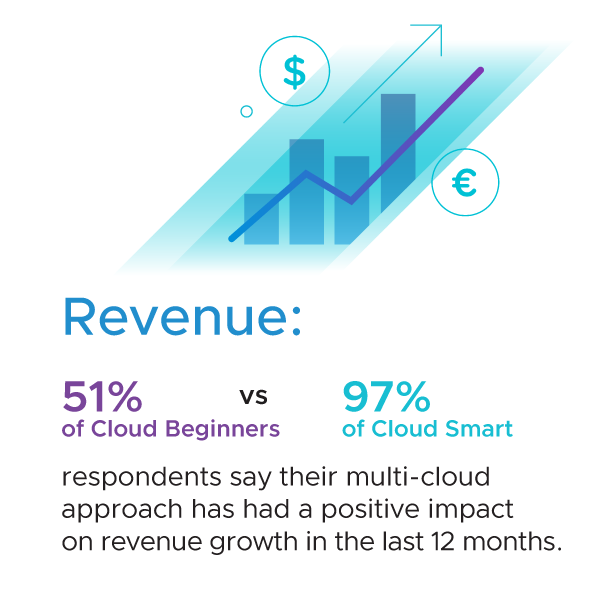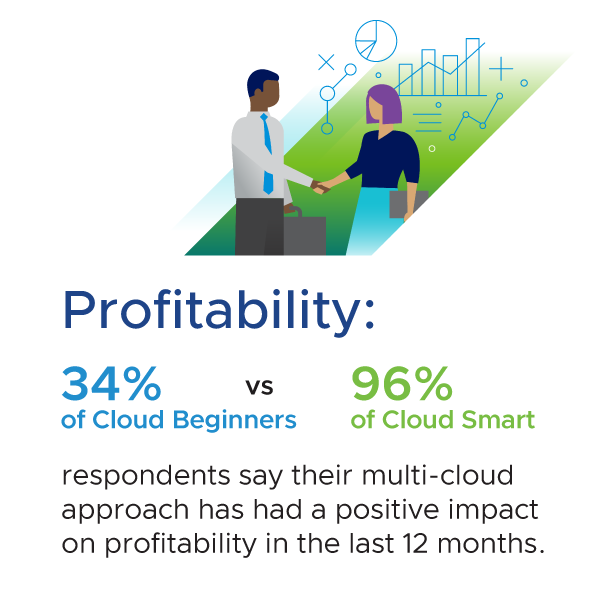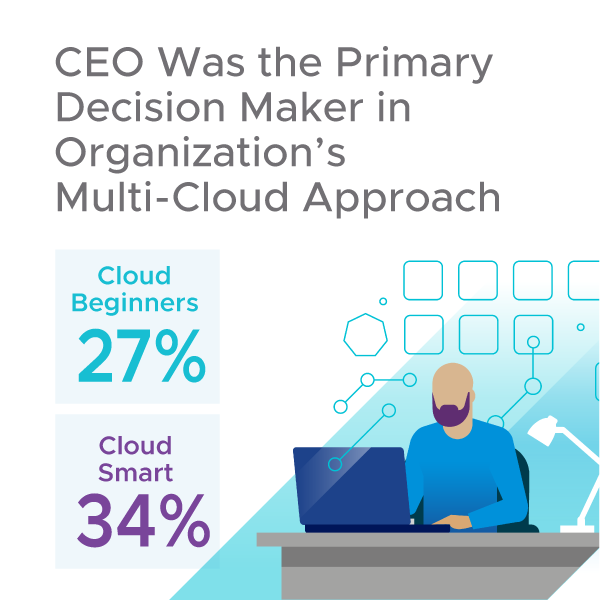Global survey from Vanson Bourne and VMware highlights the value of a smart approach to innovating across multiple clouds. Discover what cloud-smart organizations do differently than their peers.
Public-cloud adoption is so widespread that it’s easy to forget we are still in the very early stages of the multi-cloud era. In fact, the practice of running business operations across multiple clouds went mainstream during the pandemic, as the average number of clouds that an organization relies on spiked from 1.3 to 2.2 public clouds over the last two years—an increase of 69%.1
This is just one of many findings in the newly released Multi-Cloud Maturity Research Report by market-research firm Vanson Bourne and commissioned by VMware. The global survey of nearly 6,000 organizations reveals that cloud-smart organizations are navigating multi-cloud complexity better than most. And they’re translating their multi-cloud approach into competitive advantage.
The Multi-Cloud Maturity Index Research Report
Dive into all the findings from the global study analyzing organizational triumphs and challenges on the multi-cloud journey.

Chapter 1: The Cloud Conundrum
Multi-Cloud Delivers Strategic Advantages, Yet Many Struggle with Complexity
Nearly 1-out-of-5 organizations (19%) surveyed is realizing the business value of multi-cloud, while almost all (70%) currently struggle with multi-cloud complexity. At the same time, the vast majority of organizations (95%) agree that multi-cloud architectures are now critical to business success. Even more striking, 52% believe organizations that do not adopt a multi-cloud approach risk failure.
From building higher-value apps and getting them to market faster to delivering greater employee flexibility to boosting overall financial performance, the return on investment from multi-cloud is large and multi-dimensional. But that pay-off is currently reserved for companies with an ability to drive a consistent, smart approach that spans multiple clouds—especially in key areas such as DevOps, cybersecurity, cost management, data management and data sovereignty. What can early-stage cloud organizations learn from their more advanced, cloud-smart peers?
The survey shows not only the shift to multi-cloud accelerated during the pandemic but that from 2020 to 2027, organizations expect to more than double the number of public clouds they rely on.
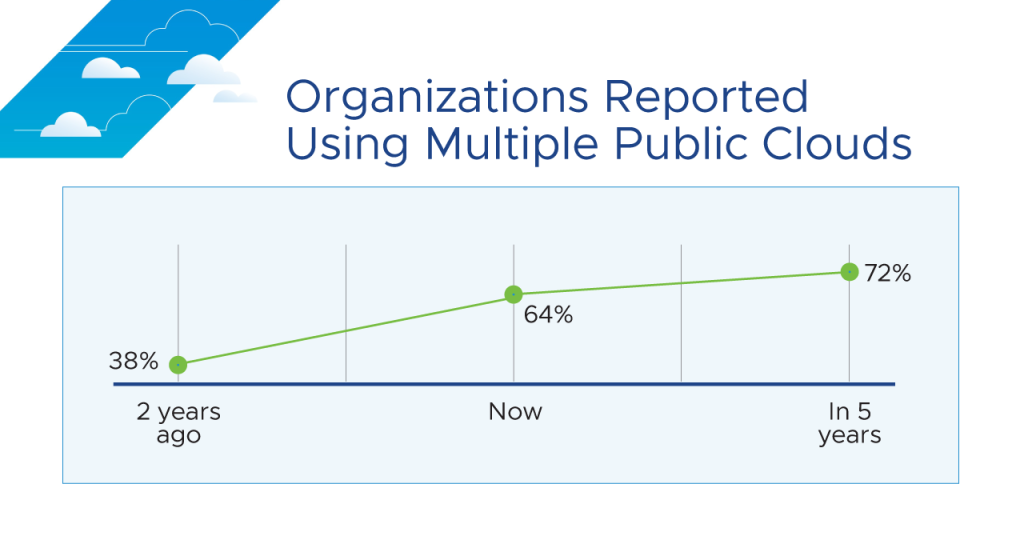
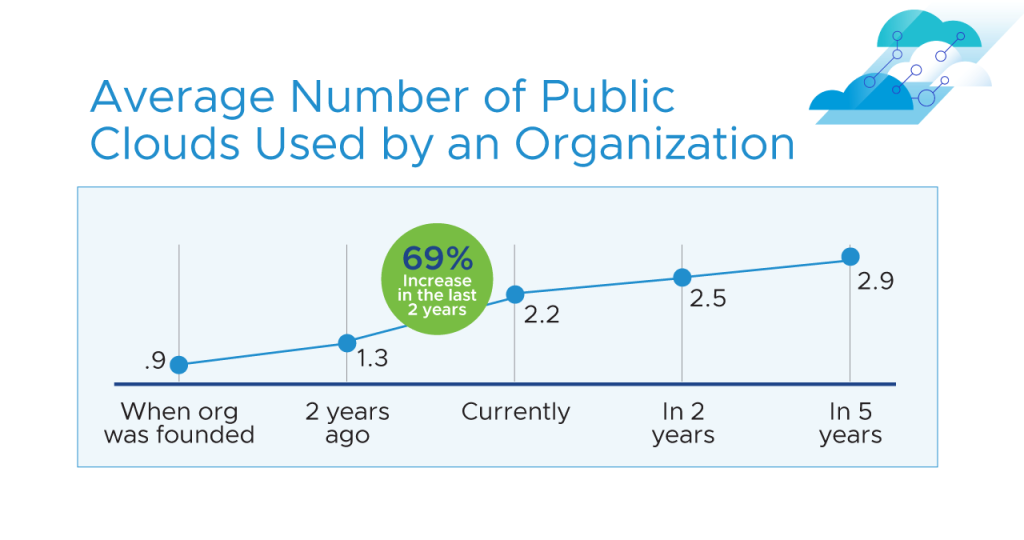
More established companies are most aggressively embracing multi-cloud while younger, high-growth challengers have a “less is more” mindset when it comes to multi-cloud.
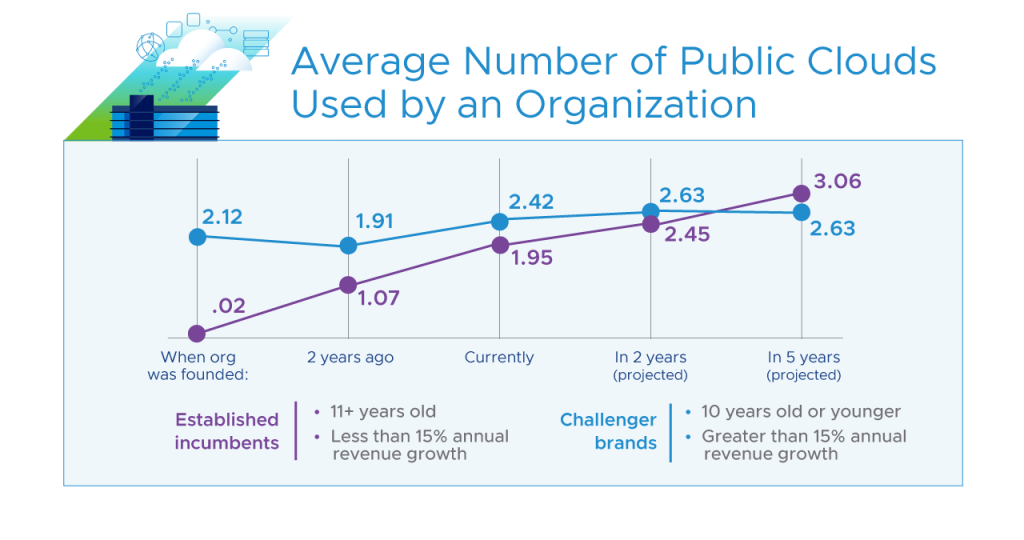
Chapter 2: Cloud Chaos to Cloud Smart
The Multi-Cloud Tipping Point
The multi-cloud tipping point is when an organization, industry or region has fully achieved the competitive advantages of multi-cloud. In the Multi-Cloud Maturity Research Report, only 19% of organizations have reached the tipping point—where the strategic advantages of multi-cloud outweigh well-documented complexities.
Key factors contributed to the categorization of respondents into four maturity levels. These included:
- The number of public clouds in use
- Hybrid app usage
- Data sovereignty capabilities
- Visibility and control over cloud expenses
- DevOps talent
- Cybersecurity
Positive or negative points were awarded by category based on level of maturity to tabulate overall scores.
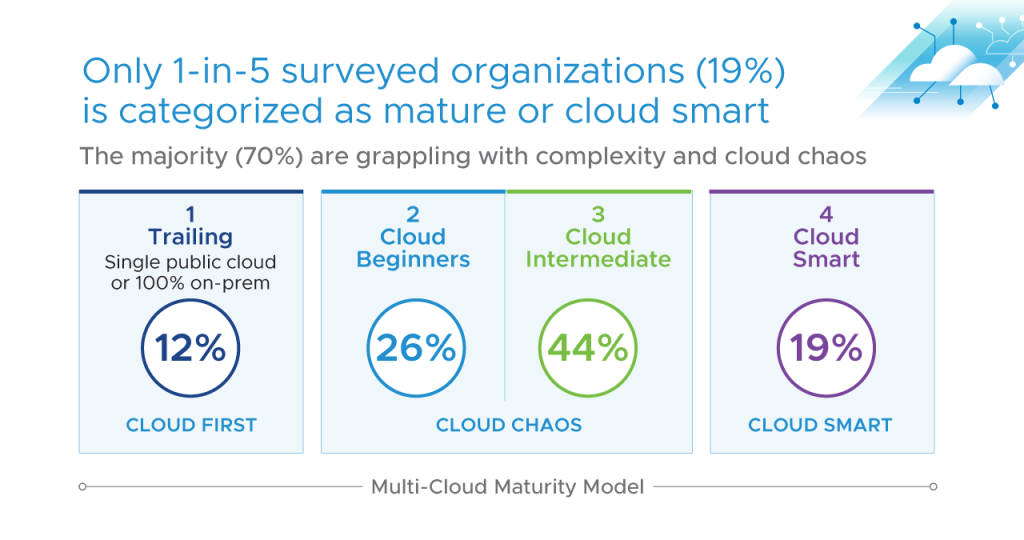
There are sharp contrasts between organizations dealing with cloud chaos and more mature, sophisticated cloud-smart organizations. A closer look at those grappling with challenges illustrates just how much companies may be missing in terms of financial gains compared to their cloud-smart peers.
Chapter 3: Turning Data into Insights & Dollars
Balancing Data Monetization & Data Sovereignty
An estimated 92% of all the data in the Western world is stored on U.S.-owned servers.
World Economic Forum2
Differing perspectives have emerged as companies, consumers, industries and governments increasingly understand the value of data or digital information. Those organizations with a multi-cloud approach are more likely to be able to maximize its value and monetize it, as it’s far easier to classify, move and use.
Around half of the respondents spanning the executive suite—CIOs, CISOs and CTOs—as well as cloud architects and DevOps, application developers and business decision makers—strongly agree that multi-cloud enables organizations to:
- Address the need for different data classifications.
- Align with national data laws and digital regulations within their sectors.
- Maximize the use of data to innovate while addressing sovereignty requirements.
With more data, the hope for many businesses is that it leads to growth. Data monetization is more likely to become a significant revenue source in the future for cloud-smart organizations, according to Multi-Cloud Maturity Research Report respondents. Significantly more so than other companies further behind on their cloud journeys.
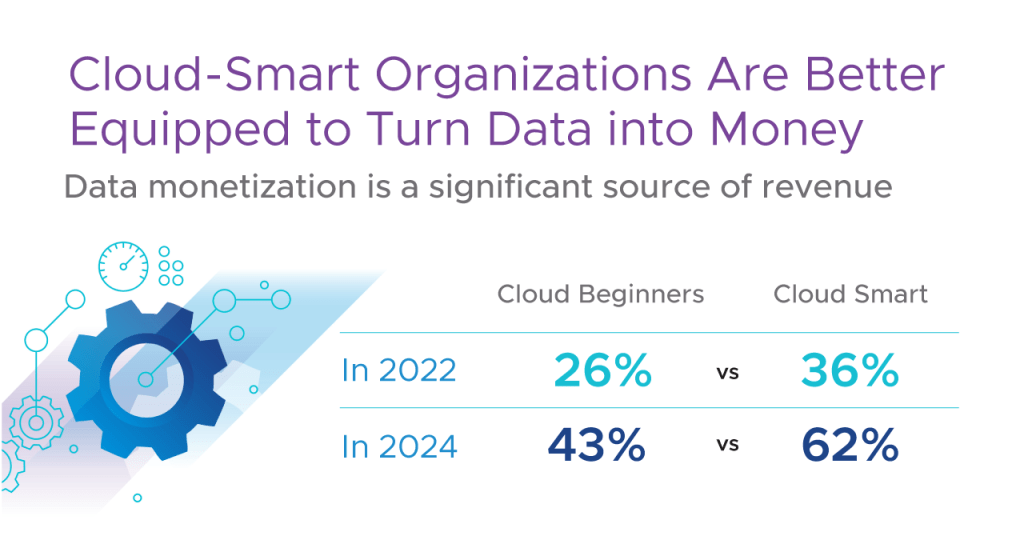
Yet while organizations may be moving more quickly to mine data for financial gain, governments and industries are tightening the rules. Data privacy laws are becoming more prevalent and complex. Nearly three-quarters (71%) of countries worldwide have data protection and privacy legislation.3 At the same time, compliance is becoming more complicated in highly regulated industries.
According to the Multi-Cloud Maturity Research Report, companies are utilizing a multi-cloud approach to address the data sovereignty challenge. But before diving into why and how, it’s important to understand the nuances of the in-country conversation about data.
- Digital sovereignty: the ability to have full control over your own digital destiny—the data, hardware and software that you rely on and create. In other words, individuals owning their own data and controlling its use.
- Data residency: the physical and geographic location where data and metadata is stored and processed.
- Data sovereignty: data is subject to the privacy laws and governance structures within the nation or jurisdiction where data is collected, stored, processed and used.
- Jurisdiction: a legal authority over data centers and clouds aligned to national standards and supported by national government.
In technical terms, these are represented by four framework principles:
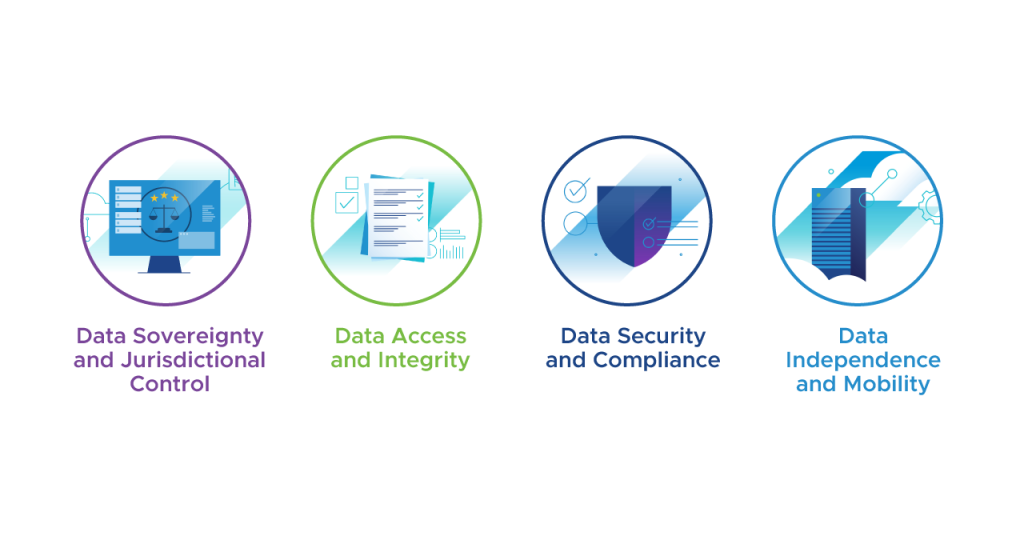
Multi-cloud strategies allow organizations to utilize sovereign-cloud providers in order to protect customer privacy and more effectively manage compliance with data-sovereignty laws.

With a cloud-smart approach, businesses are able to perform the delicate dance between data monetization and data sovereignty, so they can mine valuable data and extract revenue from it—without betraying their customers’ trust.
Raghu Raghuram, CEO, VMware
And while nearly all study respondents believe data sovereignty is a concern for their organization, cloud-smart organizations are successfully avoiding many of the burdens that face cloud-chaos organizations when it comes to managing data.

Chapter 4: Security & Compliance
Securing Data Here, There & Everywhere
The old adage is true: You can’t protect what you can’t see. Data visibility and security across clouds is a key concern in implementing a successful multi-cloud strategy, particularly as companies look to innovate by taking advantage of the unique capabilities that cloud providers deliver.
Data security remains a challenge for most, yet cloud-smart organizations report they have less room for improvement in this critical area compared to their cloud-chaos peers.
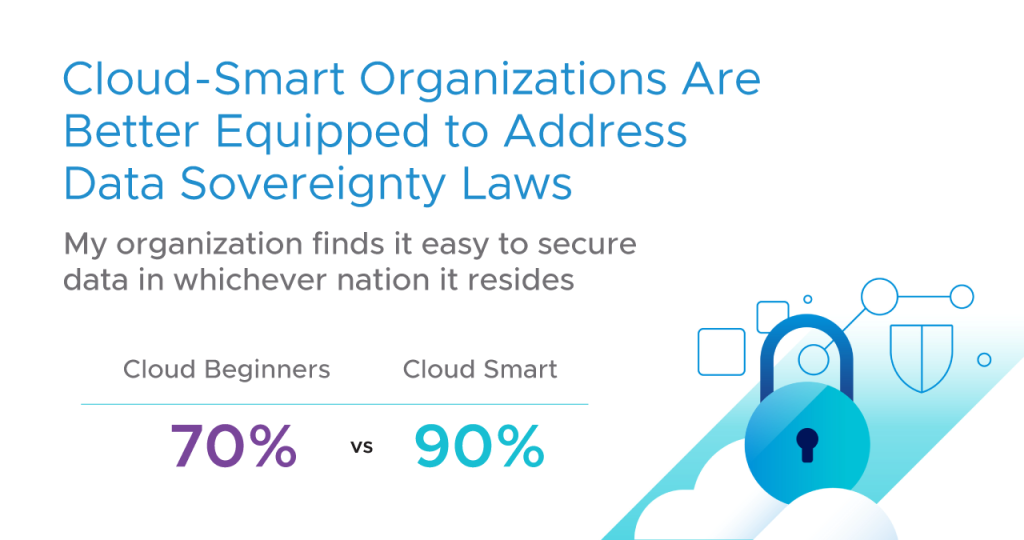
Nine-out-of-10 cloud-smart organizations say it is easier to secure data in whatever nation it resides.
A deeper dive into the data also reveals that those organizations that have hybrid apps spanning multiple clouds report an added benefit: a greater ability to manage data and security across clouds.
Organizations using hybrid apps believe multi-cloud makes data sovereignty management and security easier compared to those that don’t.
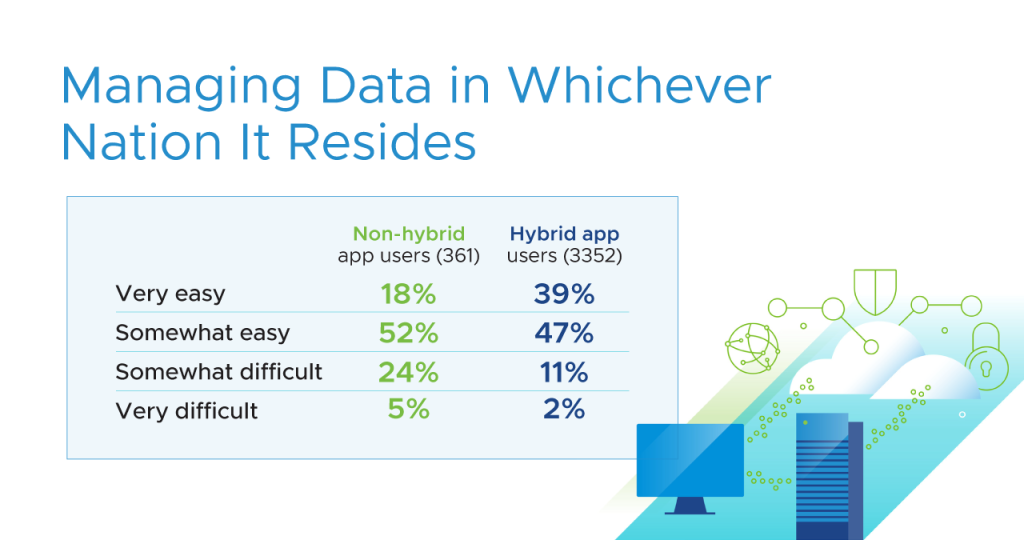
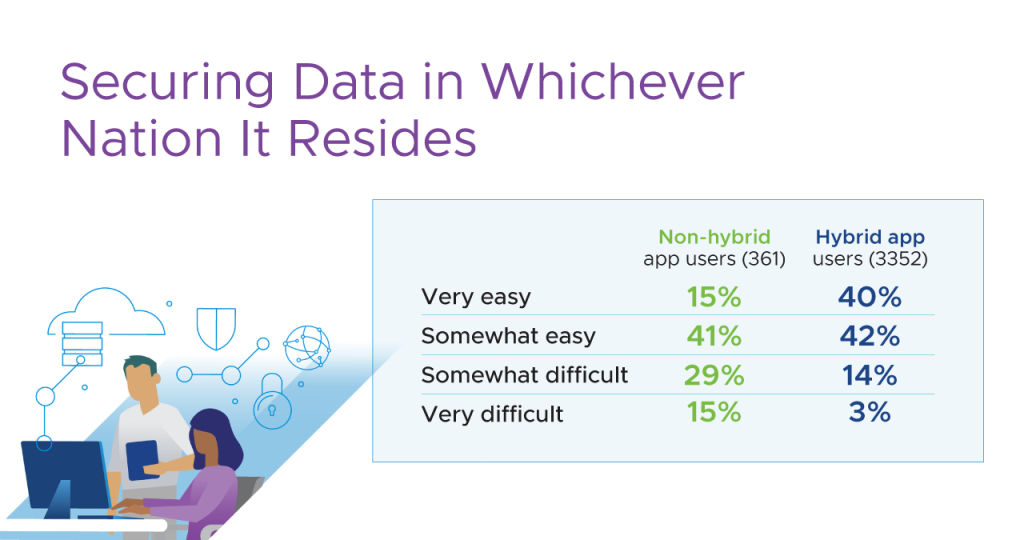
Chapter 5: Starting at the Top
Mindset & Culture Matter When It Comes to Multi-Cloud
Unlocking the potential of multi-cloud is not solely about having the right technology in place. Culture matters, and cloud-smart organizations tend to have CEOs who are extremely engaged in driving their organization’s multi-cloud strategy. Organizations that put the CEO in charge of their multi-cloud journey achieve better outcomes because top leadership involvement ensures that multi-cloud strategy aligns directly to the organization’s business objectives. In fact, cloud-smart organizations are far more likely to have the CEO as the primary decision maker when it comes to their multi-cloud strategy.
Across the board, organizations surveyed for the Multi-Cloud Maturity Research Report said they faced a shortage in the technical chops needed for multi-cloud success.
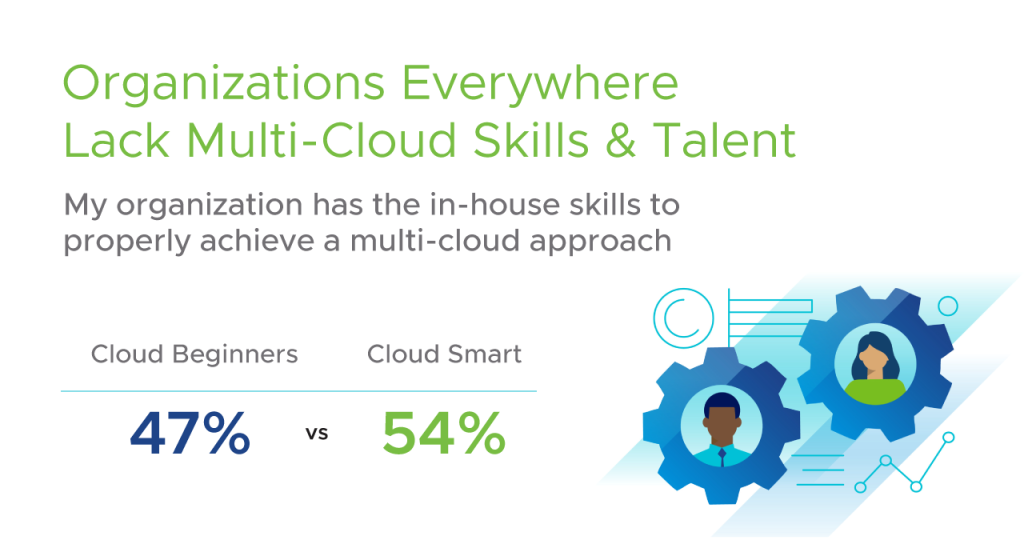
But cloud-smart organizations are doing slightly better. They have the culture and mindset to persevere and prosper with multi-cloud.

Chapter 6: Accelerating Outcomes
Multi-Cloud Value in Action
With an eye toward the future, forward-thinking leaders are leaning into multi-cloud to accelerate business outcomes.
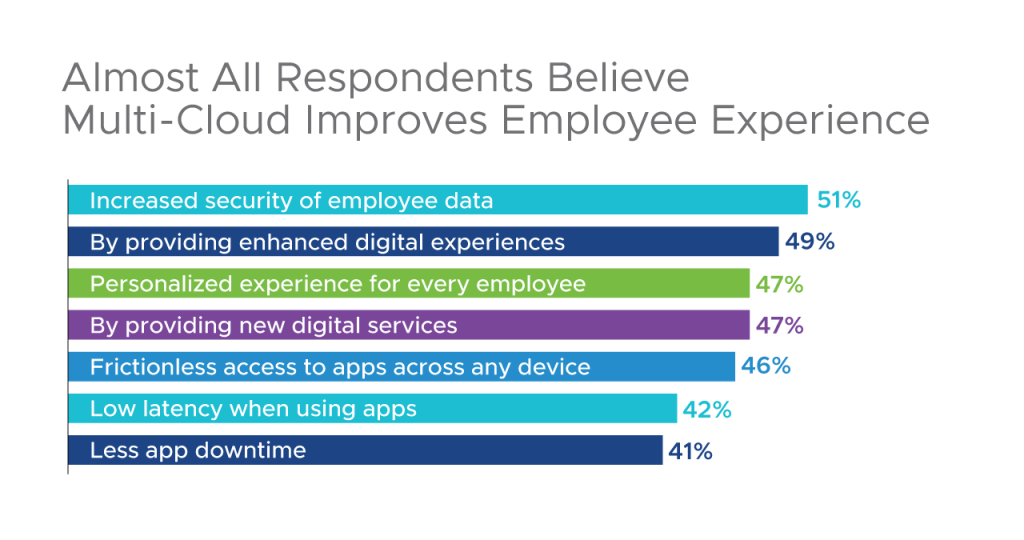
And application teams are taking a best-of-breed, multi-cloud approach, mixing and matching services from different clouds to meet their needs.

Read the stories below to see how three groundbreaking companies are using multi-cloud to drive transformation and growth.
Chapter 7: Taking the Next Step
Measure Your Multi-Cloud Maturity
Curious Where Your Organization Is On its Multi-Cloud Journey?
Answer a few short questions to see how your organization stacks up against more than 5,700 respondents worldwide.

About the Multi-Cloud Maturity Research Report
From June to August 2022, more than 5,700 C-suite leaders, cloud architects, DevOps and AppDev pros as well as business decision makers from 19 countries participated in the Multi-Cloud Maturity Research by Vanson Bourne for VMware.
Sources
- Vanson Bourne. “The Multi-Cloud Maturity Index Research Report,” October 2022.
- World Economic Forum. “What Is Digital Sovereignty and Why Is Europe So Interested In It?” March 2021.
- UNCTAD. “Data Protection and Privacy Legislation Worldwide,” December 2021.
